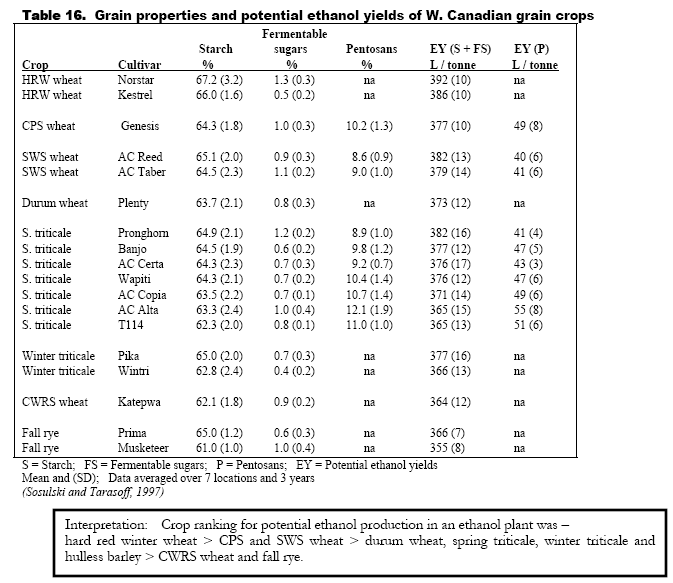| | Triticale grain for food use | Triticale grain for value-added processing and nutraceuticals | Triticale grain for industrial purposes
Triticale Grain for Food Use
Although data with the most recent Canadian varieties are lacking, triticale is considered a very suitable grain for human diets, due to its high energy and lysine levels. Although triticale is often a minor component in multi-grain breads, the overall human food market for triticale in Canada remains very small.
For bread (leavened) products, triticale lacks the gluten strength found in wheat, but its flour can be incorporated in leavened products in mixtures with wheat, where it gives a nutty flavor to products. For this purpose, processing quality is similar to and competes with Canada Prairie Spring Wheat, with medium protein level and gluten strength. Breads made from 100 percent triticale flour have texture more like rye than wheat. Breakfast cereals have also been made from it.
Triticale flour yield is less than wheat, and as a softer grain it must be milled differently. When triticale is used in multi-grain breads, production must ensure high-grade standards, including the absence of ergot bodies.
Baking trials completed by Kevin Swallow at Alberta Agriculture’s Leduc Food Processing Centre found a large difference in performance and food quality between triticale varieties:
- Tests showed that 60 percent Bobcat (winter type) flour made good quality bread, both when made by hand and in the bread machine, while 60 percent Pronghorn (spring type) flour did not.
- Neither Bobcat nor Pronghorn flours made good pasta or noodles.
- Excellent tortillas and chapattis were made from 100 percent Bobcat flour.
Overall, the study found that the triticale flour yields were less than Canadian Red Spring Wheat. The study also reported that the mill did not have to be set differently when using triticale.
Internationally, triticale has found great success in a very large number of ethnic cereal-based foods. Some of these markets where these foods are sold cite triticale’s flavour as one of its advantages. A long list of Indian foods contain triticale, where it is used in a 1:1 mix with wheat. These include: chapatti, jamoor, kesaribath, porridge, makmal poori, samosas, uppittu, halwa, shankarpoli, paratha, idli, matthi, mattar, pinni, jalebi, tortillas, comncha, Ethiopian injera and many other products.
Triticale Grain for Value-Added Processing and Nutraceuticals
Investigations are underway to see if triticale’s functional properties are different from other grains for food or non-food derivatives and uses. These properties include:
- Viscosity
- Foaming
- Emulsion stabilization
- Water binding
- Anti-oxidant
- Extrusion
Research is also ongoing to determine whether fractionation of triticale grain can identify potential value-added components. These could include: special proteins, lipids or starches, food emulsifying agents, beta-glucan, pentosans, fiber (soluble and insoluble) and tocols.
Triticale may also see use in the fight against certain diseases. Its levels of dietary fiber and lignans may be high enough for use in high fiber food products as part of a dietary approach to control cancer, coronary heart disease or maturity onset (Type II) diabetes.
Triticale Grain Use for Industrial Purposes
In the long term, demand for ethanol-based fuel will likely continue to increase in North America. Canadian spring and winter triticale varieties are suitable for use in the conversion process, offering high crop yield potential and potentially low price when compared to wheat.
Triticale has been processed in some ethanol plants in Western Canada. However, the value of the co-products produced is not as high as when Canada Prairie Spring Wheat is used as the feedstock.
Most auto manufacturers are moving to engine design that can accept as much as 85 percent ethanol in the fuel (the E85 standard). Once this standard is accepted in the United States, Canada will have to move to the same standard. This could create a significant domestic demand. Most of today’s ethanol fuel is exported to the United States.
The economics of ethanol production is best when grain prices are low and oil prices are high.
Any grain for industrial energy use (for example, conversion to ethanol) requires:
- Grain yield and price competitiveness with other grains.
- Plump kernels with a low percentage thins.
- High starch content and conversion rates to ethanol.
- A market for co-products.
- Regularized grain supply chain.
- Sufficient tax or other incentive for the ethanol to be competitive with gasoline in the fuel market.
Of these, the first five criteria are readily met by triticale at this time.
Comparative trials of different crops with different triticale varieties demonstrate that the biological value of triticale varieties is comparable to the most suitable wheat varieties for ethanol processing (McLeod et al 1997). Grain yields are also similar or better than for other cereals.
Canadian triticale varieties have generally lower fiber content than wheat, and comparable starch, fermentable sugars, pentosans, potential ethanol yields and lower protein content (McLeod et al., 1997).
From compositional studies using the same samples, Sosulski and Tarasoff (1997) (Table 16) concluded that the relative crop ranking for potential ethanol production in an ethanol plant was, from best to worst:
- Hard red winter wheat.
- Canada Prairie Spring (CPS) and Soft White Spring (SWS) wheat.
- Durum wheat, spring triticale and winter triticale and hulless barley.
- CWRS wheat and fall rye.
 .. ..
.
In some processing plants, poor gluten properties in triticale have led to “stickiness” in the extraction processes. While Canadian triticale breeders think this should not be a problem in modern varieties, the subject has not been researched at the plant-scale level. |
|